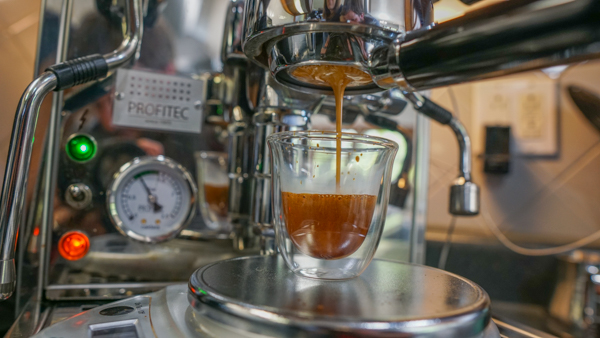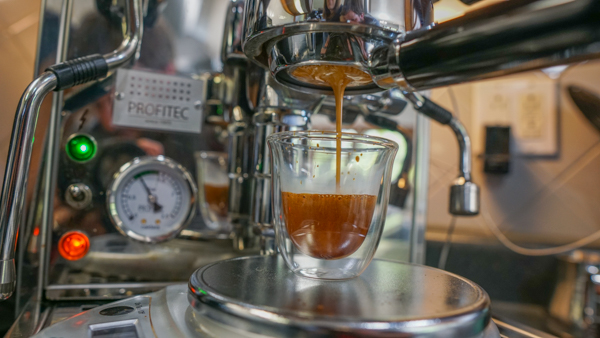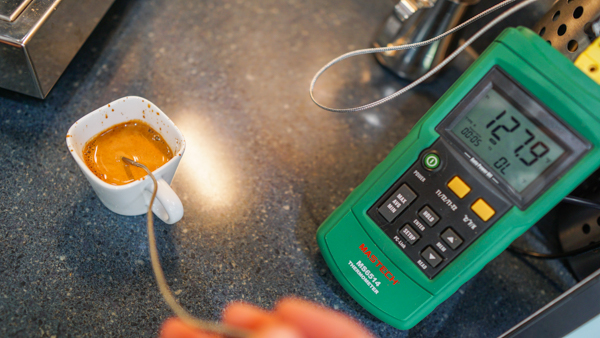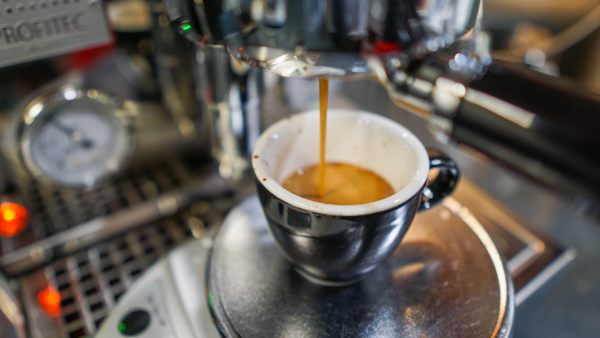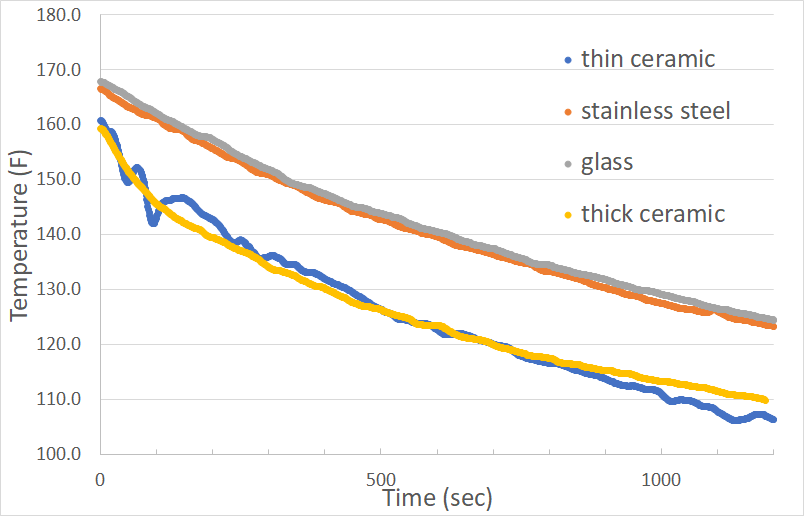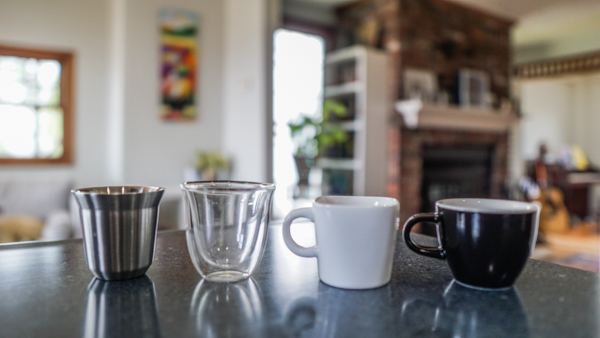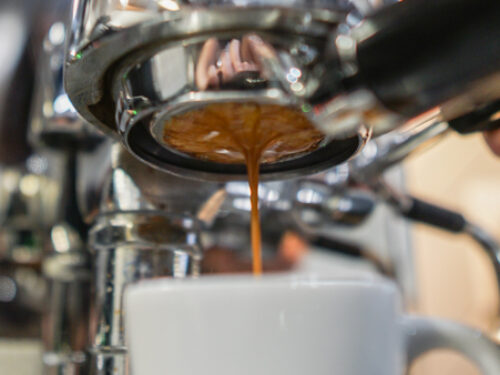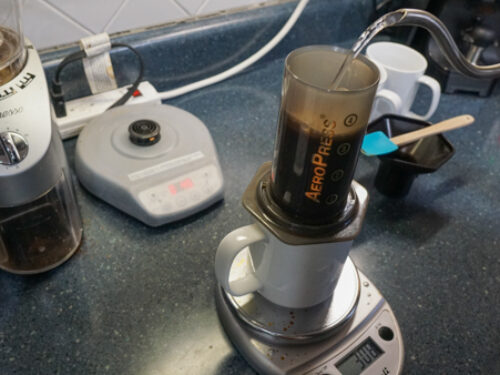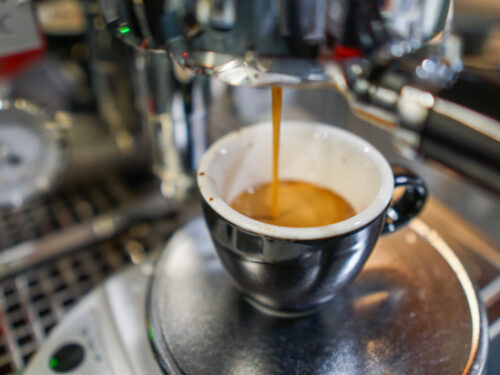Disclaimers: Our site uses demographic data, email opt-ins, display advertising, and affiliate links. Please check out our Terms and Conditions for more information.
Shopping for coffee-related gear can be overwhelming with the huge number of options out there, and the variety of espresso cups available is no exception. When it comes down to it, though, the main things we consider when buying espresso cups are material/performance, aesthetics, and cost.
We recently purchased four different types of espresso cups and evaluated them on the above criteria for their pros and cons. For performance tests, we measured espresso temperature as a function of time in each cup. In this post we share our impressions and the results of our tests so that you can pick the best type of cup for you.
Glass Espresso Cup
This glass espresso cup is double-walled, meaning there is a layer of insulating air in between the two glass layers. Therefore the cup should theoretically do a good job of keeping your espresso hot and the exterior wall cool to the touch so you can more easily handle it.
Pros: Espresso stays hot while exterior wall stays cool. It's made of glass which is aesthetically pleasing for watching the espresso settle after a shot is pulled.
Cons: For me, the only con with this cup is that it barely weighs anything. When I drink espresso or coffee I prefer to drink it out of something substantial, and this cup feels like it may just fly out of my hands if I look at it the wrong way. That said, if that doesn't bother you, this is an excellent and beautiful cup for espresso.
Stainless Steel Espresso Cup
This cup is pretty much the same size and shape as the double-walled glass cup, but it is made out of stainless steel. This is sort of an unusual material for an espresso cup but we knew it would perform differently from the glass and ceramic cups so we figured we should try it out.
Pros: This cup has a more substantial feel than the glass cup. Because it conducts heat really well, the cup wall gets pretty toasty. To me, that's a plus because if the cup is too hot to hold then the liquid inside is probably too hot to drink. I also like how there is a slight lip on the cup – it makes it easy to drink out of.
Cons: I don't know if it's all in my head, but to me, drinking espresso or coffee out of metal cups always gives it a slightly metallic taste. However, since espresso is meant to be consumed quickly, this didn't bother me as much with this cup as with, say, my stainless steel travel mug.
Thin Ceramic Espresso Cup
This thin ceramic espresso cup came in a set of six complete with saucers and a little stand to hold everything. It's the kind of basic, affordable set that many people (including me) start out with.
Pros: If you're looking for a complete espresso cup set that's affordable, odds are it will include a thin ceramic cup like this one. You really can't go wrong with the classic white aesthetic for serving espresso.
Cons: We've broken a few of these now, so their fragility can be a con. Also, as we will describe in the next section of the article, espresso cooled down more quickly in this cup than the glass and stainless steel cups.
Thick Ceramic Espresso Cup
This thick-walled ceramic cup is made by Acme & Co. which has a great reputation in the coffee world. If you frequent third wave coffee shops, chances are you've been served an espresso in this style of cup.
Pros: This cup wins hands down for me in terms of best aesthetics and best espresso drinking experience. I love the weight of the cup in my hand, and drinking out of the thick wall of the cup is to me a better feeling than drinking out of a thinner wall.
Cons: This was the most expensive cup out of all of the ones we tested, but we think the quality is worth it. Also, as described in the next section, espresso cooled down more quickly in this cup than in the glass and stainless steel cups.
While the above sections summarized our thoughts on each of the cups, if you want to dive deeper into the performance tests, the rest of the article is for you.
Espresso Cup Temperature Performance
We performed tests where we measured the temperature of an espresso shot in each cup over time using a thermocouple. All of the cups were pre-heated by sitting on top of our espresso machine for several hours prior to starting the tests. The same coffee dose and shot volume were used for each cup.
Below you can see the results from each test overlayed on the same graph. You'll notice that the stainless steel and glass curves are grouped together, while the thin and thick ceramic curves group together separately at lower overall temperatures.
The main thing to take away from this plot is that at a given time point, the espresso shots in the ceramic cups are cooler than those in the stainless steel and glass cups. This makes sense given that the specific heat capacities of stainless steel and glass are higher than ceramic. Therefore, when you pull an espresso shot into a ceramic cup, more of the energy from the shot goes to heating up the cup than it does in the stainless steel and ceramic cups.
Bottom line? Our shots were cooler in the ceramic cups than in the stainless steel and glass cups. One way to mitigate this when using ceramic could be to fill your cup with hot water and let it warm up for a few minutes prior to dumping the water and pulling your shot.
Given the temperature test results as well as all of the pros and cons previously mentioned, our overall favorite cup of the four we tested is the thick ceramic followed by the glass cup. Although the thick ceramic performed the worst in the temperature tests, we drink espresso so quickly that it doesn't bother us so much. We love the heftiness of the thicker ceramic cup; it's just a pleasure to drink out of. The glass cup is a close second favorite as it's cool to see a cross-section of the espresso shot and to watch the crema rise and separate.
Overall, when looking for an espresso cup, if you like a classic aesthetic and a heftiness, consider a ceramic cup (just be ready to pre-heat your cup with hot water before pulling your shot). If you're the kind of person who likes to linger with your espresso or likes a more modern look in your cup, a double-walled glass cup is a solid choice. Although the stainless steel cup was not our favorite to drink out of, it could be a good option if you're looking to collect the shot for pouring in to a larger milk drink in another cup.
What is your preferred espresso cup style? Comment below to share!

